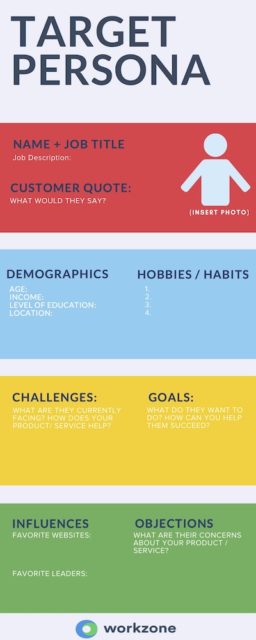From newbies to seasoned professionals, from small business to large corporations, every marketer needs to have a plan to make sure she’s doing her job efficiently and effectively.
Why Do You Need A Marketing Plan?
A marketing plan helps you get everyone in your company on the same page, allows your business to be proactive with generating sales, guides your messaging to stay aligned with your vision and mission, makes it easy to evaluate new opportunities, and ensures your marketing dollars are giving you the highest return on investment (ROI.)
There are many moving parts and writing up a marketing plan from scratch can be overwhelming.
To help you get started writing a marketing plan, or to fine-tune your existing marketing plan, consider these 9 critical elements:
1. Determine Goals and Objectives
First, you need to set the stage and know where your company needs to go before you can decide on the marketing activities that’d take you there.
This may sound simple, but many marketers have the tendency to get sucked into the execution of tactics before they define what makes up success for their efforts.
Here are some examples of what your goals or objectives could look like:
- Getting into a new marketing
- Enticing customers to switch from a competitor to your products or services
- Increasing the reach and sales of your products
- Launching a new product or services that either meet the needs of your current customer base or help you get into a new market
After you’ve set your goal, then you need to define what success looks like by using specific numbers.
First, do this at a high-level – e.g. increase revenue by 20% within 6 months.
Then drill down to the specifics to show how you’d do that goal: e.g. adding 200 new customers per month for the next 6 months, increase the amount spent by each customer by 10% in 3 months, or increase client referral by 50%.
2. Understand Your Target Audience/Market
Your marketing won’t be effective if you’re not talking to the right people.
It’s very important to identify the audience or customer profile for the specific goal indicated in your marketing plan.
Your target audience profile should include demographic information such as age, gender, geographic location, purchasing power etc.
You also want to cover psychographic information and understand how to appeal to the audience’s values, desires, and challenges. Such profile could be informed by the books or magazines they read, the websites they visit, TV shows they watch, or other lifestyle choices.
This step will help you understand your market’s decision-making process, where they seek information, and factors that influence their purchases.
How To Write An Exceptional Creative Brief (WITH 10 FREE MARKETING TEMPLATES)
3. Do The Right Research & Analysis
To help ground your marketing plan in the current market landscape and see how you can stand out from your competitors, you need to do some research.
Competitive Analysis
Research direct competitors that provide similar solutions and serving the same target market, then analyze the following:
- Product attributes
- Pricing
- Marketing and promotion strategies
- Distribution channel and method
- Products or services offered
Since many businesses use inbound marketing and content marketing, make sure to survey the content landscape by “spying on your competition” – especially by taking notes on what your competitors are doing with email and social media marketing.
You’ll get insight into keywords and key phrases your customers are searching for, the kind of content you competitors are ranking for, and ways to carve out a unique positioning and drive traffic to your website.
SWOT Analysis
This acronym is now standard practice in essentially all marketing plans. SWOT stands for strengths, weakness, opportunities and threats. This analysis gives you insights into how you can differentiate your products or services, and claim your unique positioning in the marketplace.

4.Who’s Your Target Persona?
Your buyer personas flesh out the details of the market segment you’re targeting in your marketing plan, and inform how you can create highly relevant content or messaging to build awareness and drive traffic.
The buyer personas should be specific to achieving the goals and objectives of your marketing plan. They may overlap with the personas you already have developed for your general marketing efforts, or they may be slightly different – especially if your marketing plan focuses on getting into a new marketing or launching a new product or service.
5. Know The Customer Lifecycle
Buyer personal only tells half the story. To create copy and content that appeal to a specific audience, you also need to understand where they are at in the customer lifecycle.
There are a few ways to divvy up the lifecycle stages, e.g. Awareness, Comparison, Selection, and Decision. You can select a series of stages that best reflects how your ideal customer interacts with your business to inform your planning and strategy.
After you have created your buyer persona and defined the customer lifecycle, you can merge this information in a content map.
This will inform the type of content to create, the marketing strategies to put in place, and the promotional channels to use.
6. Create a Unique Selling Proposition
Defining your unique selling proposition is an important step in crafting a marketing strategy that works.
A unique selling proposition tells your prospects why you’re different, sets your brand apart from your competition and allows you to target a very specific audience that would most likely to find your products or services relevant and valuable.
To articulate your unique selling proposition in a way that helps inform your marketing plan, you need to be able to:
- Clearly define your target market
- Explain the problem you solve for your market
- Articulate the most distinct and relevant benefits you offer
- Define the “big promise” your products or services deliver
- Highlight how your brand personality appeals to your ideal audience
After you have listed out the above factors, you can work them together into a succinct paragraph, which you can include in your marketing plan to help your team stay focused.
7. Measure Your Goals
You won’t know whether you plan is effective or not, nor would you be able to improve upon it, if you aren’t measuring the results of the strategies and tactics.
Your marketing plan needs to define the critical KPIs (Key Performance Indicators) to track, such that you can gauge its effectiveness and ROI (Return on Investment.)
Your KPIs should reflect the goals and objectives you’ve defined in step 1. There are a lot of metrics you can measure, however, if you’re chasing the wrong set of data you may be creating a lot of busywork for you and your team.
Here’re some examples of KPIs you can track:
- Sales growth
- Leads generated
- Lifetime value of a customer
- Cost of customer acquisition
- Email marketing performance
- Website conversion rate
8. Use The Right Marketing Tactics
Once you have defined your buyer persona, lifecycle stages, and unique selling proposition, you can select the most suitable tactics that meet your target audience where they’re at while highlighting the strengths of your company and helping you move toward your goals.
As technology is making different forms of marketing more accessible to brands big and small, there’s also the danger of chasing bright shiny objects instead of focusing on tactics that will move the needle most.
Use your goals and objectives, as well as your content map that combines critical information about your buyer personas and lifecycle stages, to inform the selection of marketing tactics so you don’t get sidetracked.
For example, you run a graphic design business and your goal is to bring in 15 new clients in 3 months. You’re quite comfortable with your conversion rate so you figure you need to increase the number of qualified leads that would inquire about your service.
In this case, you want to employ tactics to generate and nurture leads.
There are many ways to achieve the same result, and you need to narrow down your selection so you can focus your resources. You may consider how your ideal audience prefers to consume content, or how your content is best presented.
You know your ideal audience prefer to read rather than watch a video – so your medium of choice could be an ebook and/or emails. Or, you want to show annotate visual examples – which means a PDF would probably work much better than audio.
In this example, after considering all the factors, the best tactic could be to generate leads by targeting audience in the awareness stage with a free ebook on graphic design for small business websites, and then funnel subscribers through a lead nurturing email sequence to build trust (moving them through consideration stage) before an offer for a complimentary consultation to help them evaluate their graphic design needs is made (targeting those in the decision stage.)
9. Create a Budget and Update It
Marketing is an essential investment for any business, and it’s important to set aside a dedicated budget for marketing and promoting your products or services.
After you’ve defined your budget, you may need to revisit the marketing tactics to make sure you can support the promotional efforts in a way that can yield results.
Not all marketing tactics will cost you an arm and a leg. You can optimize your marketing budget with some careful planning:
- Focus your resources on what works best
- Use tactics that allow full control of your spending
- Don’t scale a tactic until you’ve proven its ROI
- Use cross-channel remarketing to increase effectiveness
Conclusion
These 9 elements we just covered will certainly change over time as your business evolves.
Your marketing plan should be a living breathing document that you revisit regularly to help you stay on track with your goals, keep current with your market, and make sure you’re using the most effective tactics to promote your business.




